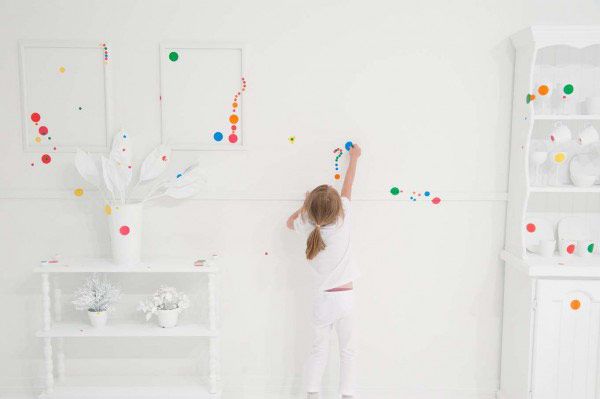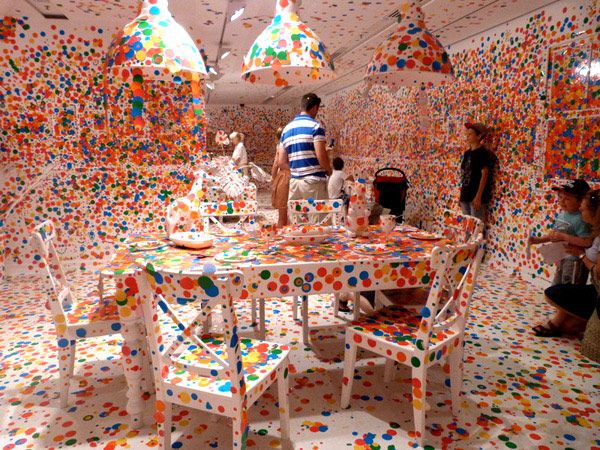 |
| Yayoi Kusama "Obliteration Room" 2011-12 |
Yayoi Kusama calls herself an "obsessive artist." Indeed, she's obsessed with polka dots; her paintings, sculptures, and constructed environments are almost always speckled with them. But Kusama's singular commitment to circles and pattern isn't her only "outsider artist" qualification. Since the mid-1970s, the artist has voluntarily committed herself to a Tokyo mental hospital, where she continues to create new work.
I recalled this last fact when I first saw photographs of Kusama's "Obliteration Room," an installation included in her "Look Now, See Forever" solo exhibition at Australia's Queensland Art Gallery of Modern Art. "Obliteration Room" began as a completely whitewashed interior space. The room's couches, bookshelves, kitchen table, cupboards, house plants, and piano were all colorless. When the museum exhibition opened, colorful stickers were distributed to installation visitors, and children were especially encouraged to cover whatever they pleased. Over time, the whitewashed installation has exploded in vibrant color, its once discernible space transformed into a perception-warping experience. The room, as the installation's title predicted, has been obliterated.
 |
| Yayoi Kusama "Obliteration Room" 2011-12 |
"Obliteration Room" might arouse the ire of Jerry Saltz and other critics weary of Relational Aesthetics. Despite countless curatorial essays complicating its definition, Relational Aesthetics is just a term applied to artwork that incorporates viewer interaction. Most of the artists celebrated for their Relational Aesthetic achievements -- Rirkrit Tiravanija, Carsten Höller, and Pierre Huyghe are the best known representatives -- produce work that, as Saltz wrote in his December New York magazine column, fails to provide "much in terms of form, social commentary, or the willful transformation of materials. It’s arty junk food."
 |
| Yayoi Kusama "Obliteration Room" 2011-12 |
 |
| Yayoi Kusama "Obliteration Room" 2011-12 |
 |
| Yayoi Kusama "Obliteration Room" 2011-12 |
Image credit: top three images, courtesy Queensland Art Gallery and Mark Sherwood; bottom two images, Stuart Addelsee

8 comments:
Sometimes I think we need Arty Junk Food to engage the general public in the whole idea of making art. The interest meter in anything zooms up 1000% after you've engaged in the process. (And you've discussed the importance of the populist approach in the past.)
Can I just say that the idea of voluntarily committing oneself to an institution holds huge appeal to me. Imagine how much more time you'd have to work on your art!
@ Andrea:
I think Saltz intended to distinguish between "arty junk food" and engaging, fun art. He was critiquing the tendency of artists and curators to claim that a playground slide placed in a museum is art, but the same slide outside of the museum is not. Granted, definitions of art are slippery, but just because something fun is in an art setting doesn't make it art....it makes it "arty." Or something like that. ;)
Kusama's installation, however, is both fun and art. It succeeds all around...and I agree that it's a great representative of the "populist approach."
With respect to self-institutionalization, I can't claim to have never considered that route!
Whats the difference from Damien Hirst? Instead of hiring lots of assitants, just leave abuncha twister spots and let people put them wherever. How is this art, and why does it have to start as the sterilized arschool white cube?
Why not wood? Or many colored walls, that would make people actually think about where to but them and the relationship to both the enivronment and the others who have decided. One spot per customer.
Still not art, but far more effective towards your stated goal. This is just romper room stuff. Chris Burden does better, ugh.
PS Dont think Jerz cares for me anymore, our relationship is broken, sob.
Smart kids dont like intelligent ones. There is a difference.
@ Donald:
I think there's a significant difference between Hirst's dots -- so clean and controlled, vaguely clinical -- and Kusama's beautiful mess....or rather, the beautiful mess that Kusama set the stage for. Hirst's dot works don't turn our perception upside down, jarring us from the hum-drum. They're attractive, even seductive, in a laboratory kinda way, but they don't throw me for a loop.
How is the Kusama art, you ask? Well, that's a big question. Defining art is nearly impossible, after all. I consider it art, though.
I dont find it difficult at all, its effectiveness is more up to temperament and experience. There are simply several forms of art based on purpose. each has its own needs, to not fulfill them makes it not art or that form.
Attempting to nulify the Word makes them useless as it must have a meaning to be a symbol, which is all words are. You cant redefine something that has always been, Just find a new word for it. PreConceptualism and Sub Minimalism belong in SmartAsz Art, because it sure as hell aint intelligent.
Intelligence demands meaning, relevance and doing. Commitment, responsibility and sacrifice. I see games and therapy. Contempt art is clever. Trained to think a certain way to be a part of the crowd, not be independant and observing as things are on all planes of existence, but how Academics want them to be. Smart. And ever so cute.
That is not Adult.
And like KJAZ hiring Kenny G as a DJ that just dumbs down its meaning and insults those have worked so hard and sacrificed for Art. No one who likes Kenny the noodler over 20 years old will never get real art music. They might come, but they wont stay, and makes real Jazz appear retarded to those who could feel it.
@ Donald:
You write:
"I see games and therapy. Contempt art is clever. Trained to think a certain way to be a part of the crowd, not be independant and observing as things are on all planes of existence, but how Academics want them to be. Smart. And ever so cute."
Sadly, I think you're correct (though the picture is more complicated, not so black and white), but I don't see Kusama's piece falling into the clever/academic camp at all.
And as for the definition of art, it remains elusive and subjective, part of its power, for good and for ill. I have my preferences -- visual and intellectual -- but to assert that there is one True way, as many a critic has done in the past, is disingenuous and ideological.
There are many, English is a weak language in certain aspects, though being a mutt it is very adaptable. Art is a coverall word, there needs to be more, or categories.
While I feel for Miles Davis and understand the ghettoization he felt, saying Jazz is a white mans word, he just made some more music, there needs to be differentiation of Purpose. Otherwise how the hell am i going to find truly unitary sounds? That of mind, body AND soul as one. that is rare, and most jazz is entertainment, his was almost always creative art.
Let the kids go and have fun, but times are tough, there is no room for this anymore. For that is all we have had for decades now
. Time to manup, or womanup, and search for direction. There is none here. What unites us, binds us as a common humanity. That is excluded from the museo/academic/gallery complex. That would be a threat. This most surely isnt. I dont get anything from this but play.
There is no obliteration here, no nature, no coming or going, just stickers, stuff, no relationships which is where art gets its energy and power. Enough of the Trivial Pursuit generations, Knowledge must be used for good, not wasted. The future belongs to the most effecient this is total waste.
Time to seek Purpose. But that seems to be far too hard for the artscene. Games and therapy. Few are privileged enough to do only that. And so, this is irrelevant and an insult to 99% of humanity, and even higher percentage of artists who have come before us.
It is time to put aside childish things.
St Paul and some guy named Obama
Post a Comment